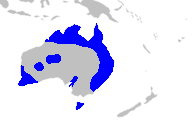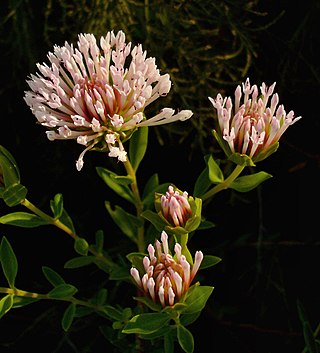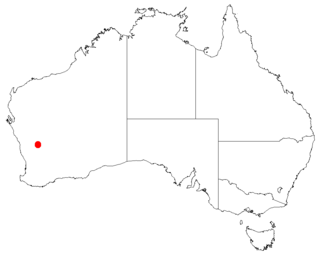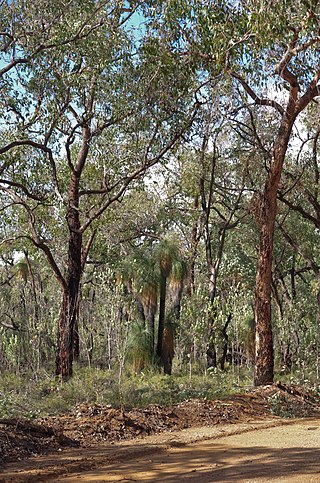
Xanthorrhoea is a genus of about 30 species of flowering plants, in the family Asphodelaceae. They are endemic to Australia.

Acacia aphylla, commonly known as the leafless rock wattle, twisted desert wattle or live wire, is a species of Acacia which is endemic to an area around Perth in Western Australia

Pimelea calcicola is a species of flowering plant in the family Thymelaeaceae and is endemic to part of the west coast of Western Australia. It is an erect to spreading shrub with elliptic leaves arranged in opposite pairs, and head-like racemes of pale to deep pink, tube-shaped flowers surrounded by leaf-like involucral bracts.

Eremaea pauciflora is a plant in the myrtle family, Myrtaceae and is endemic to the south-west of Western Australia. It is a shrub with small leaves and orange flowers at the ends of its branches. It has the most widespread distribution of the eremaeas with considerable variation in its characteristics so that three varieties are recognised. It was the first Eremaea to be described formally but was not originally given the name Eremaea.
Calothamnus superbus is a plant in the myrtle family, Myrtaceae and is endemic to the south-west of Western Australia. It is an erect, often spreading, straggly shrub similar to Calothamnus aridus with its red flowers having 5 stamen bundles, but its leaves are longer and wider. It has a limited distribution near Pigeon Rocks south of Lake Barlee.

Acacia woodmaniorum, also known as Woodman's wattle, is a shrub belonging to the genus Acacia and subgenus Alatae. It is native to a small area in Western Australia.

Acacia unguicula is a shrub of the genus Acacia and the subgenus Plurinerves. It is native to a small area in the Mid West region of Western Australia.

Hakea lasianthoides is a shrub or tree in the family Proteaceae and is endemic to Western Australia. It has creamy-white flowers, mostly linear leaves and flowers from September to November.

Grevillea hislopii is a species of flowering plant in the family Proteaceae and is endemic to a restricted area of the south-west of Western Australia. It is a dense, single-stemmed shrub with linear to narrow elliptic leaves and clusters of hairy, whitish-grey flowers.

Grevillea rara, also known as the rare grevillea, is a species of flowering plant in the family Proteaceae and is endemic to a restricted part of the South West region of Western Australia. It is a prostrate, sprawling shrub when young, later a dense, prickly shrub with pinnatisect leaves with linear lobes, and clusters of white to pale pink flowers.

Darwinia hortiorum is a species of flowering plant in the myrtle family Myrtaceae and is endemic to Western Australia. It is a compact, densely branched shrub with small leaves and inflorescences composed of up to twenty flowers with glossy, pale yellow to reddish petals and fleshy dark green sepals surrounded by papery brown bracteoles.

Xanthorrhoea drummondii, commonly known as blackboy, grasstree or Drummond's balga, is a species of grasstree of the genus Xanthorrhoea native to Western Australia.
Xanthorrhoea brevistyla is a species of grasstree of the genus Xanthorrhoea native to Western Australia.

Xanthorrhoea brunonis is a species of grasstree of the genus Xanthorrhoea native to Western Australia.

Xanthorrhoea gracilis, commonly known as the graceful grasstree, grassboy or mimidi, is a species of grasstree of the genus Xanthorrhoea native to Western Australia.

Xanthorrhoea nana, commonly known as dwarf grasstree, is a species of grasstree of the genus Xanthorrhoea native to Western Australia.

Xanthorrhoea platyphylla is a species of grasstree of the genus Xanthorrhoea native to Western Australia.

Xanthorrhoea thorntonii, commonly known as Cundeelee grasstree, Cundeelee blackboy, desert grasstree, yacka or grasstree, is a species of grasstree of the genus Xanthorrhoea native to central Australia. It is known to the Pitjantjatjara people as kata-kultu, kata-puru, ulpa or urara, the Warlpiri people as yurlurnkuru and the Arrernte as lunkere. X. thorntonii is the only grass tree found in Central Australia including the Great Sandy Desert, Great Victoria Desert and MacDonnell Ranges.
David John Bedford, is an Australian botanist and plant taxonomist who worked as a scientific executive officer and botanist at the National Herbarium of New South Wales. He is notable for his revisions of the genus Xanthorrhoea as well as many new species such as Xanthorrhoea acanthostachya.

Pimelea brevistyla is a species of flowering plant in the family Thymelaeaceae and is endemic to the south-west of Western Australia. It is a shrub with narrowly egg-shaped leaves arranged in opposite pairs, and head-like racemes of white, tube-shaped flowers surrounded by yellowish involucral bracts.

















